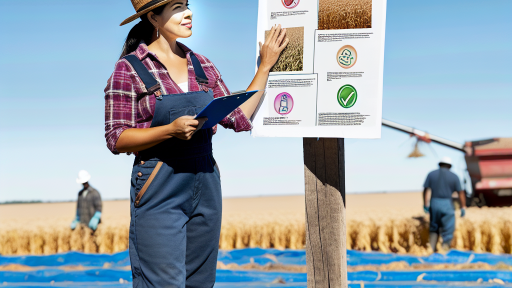Overview of Rural Development Policies and Their Impact on Farming
Rural development policies shape the agricultural landscape significantly.
These policies aim to enhance the quality of life in rural areas.
They also promote sustainable farming practices and economic growth.
In recent years, various governments have revised their rural development strategies.
Such changes often reflect evolving agricultural challenges and environmental concerns.
Objectives of Rural Development Policies
The primary goal is to reduce rural poverty and promote rural prosperity.
Additionally, enhancing agricultural productivity is crucial.
Policies also aim to improve rural infrastructure and public services.
This includes access to education, healthcare, and transportation.
Influence on Farming Practices
Farmers must adapt their methods to comply with new regulations.
For instance, policies may require sustainable farming techniques.
These techniques often focus on resource conservation and soil health.
Moreover, financial assistance programs encourage farmers to innovate.
Training and support enhance farmers’ abilities to implement new practices.
Impact of Technological Advancements
Rural development policies often incorporate technology in farming.
Transform Your Agribusiness
Unlock your farm's potential with expert advice tailored to your needs. Get actionable steps that drive real results.
Get StartedNew technologies enhance efficiency and yield in agricultural operations.
Farmers adopt precision agriculture to optimize their resources.
This approach minimizes waste and maximizes productivity.
Challenges Faced by Farmers
Despite the benefits, farmers face significant challenges.
Policy changes can create uncertainties in agricultural markets.
Additionally, the need for investment in new technologies can be daunting.
Farmers must navigate complex compliance requirements effectively.
Adapting to New Policies
Successful adaptation requires ongoing education and flexibility.
Farmers should stay informed about policy changes and best practices.
Collaboration with agricultural extension services proves beneficial.
Furthermore, forming cooperatives can enhance resource sharing and support.
Key Changes in Rural Development Policies Affecting Agriculture
Financial Support and Incentives
Recent policies have introduced new financial support mechanisms for farmers.
These mechanisms include grants and low-interest loans.
Moreover, the focus has shifted towards sustainable practices.
Farmers can now access subsidies for adopting eco-friendly technologies.
This change incentivizes reduced environmental impact.
Land Use Regulations
New land use regulations prioritize sustainable agriculture.
Accordingly, policies now encourage the conservation of natural resources.
Farmers must adapt by implementing soil conservation practices.
They should also explore crop rotation strategies to maintain soil health.
Non-compliance may result in penalties or loss of subsidies.
Market Access and Fair Trade Practices
Market access initiatives are becoming increasingly important.
Farmers now benefit from improved access to local and international markets.
These initiatives promote fair trade practices.
Showcase Your Farming Business
Publish your professional farming services profile on our blog for a one-time fee of $200 and reach a dedicated audience of farmers and agribusiness owners.
Publish Your ProfileFarmers are encouraged to participate in cooperatives.
This participation fosters collaboration and strengthens community resilience.
Technological Advancements and Innovation
Policies now support the adoption of advanced agricultural technologies.
Farmers can utilize precision agriculture tools to enhance productivity.
Additionally, access to data-driven insights is improving decision-making.
Innovative practices contribute to resource efficiency and yield optimization.
Farmers must stay informed about emerging technologies to remain competitive.
Climate Change Mitigation Strategies
New policies emphasize climate change adaptation in farming.
Farmers are encouraged to implement practices that reduce greenhouse gas emissions.
These practices may include improved manure management and cover cropping.
Government programs also support research on climate-resilient crops.
Ultimately, adaptation is crucial for long-term agricultural sustainability.
Community Engagement and Capacity Building
Community engagement has become a vital aspect of rural policies.
Programs focus on building the capacity of local farmers.
Workshops and training sessions provide essential knowledge and skills.
Farmers learn best practices for sustainable farming techniques.
This engagement fosters a sense of community ownership and cooperation.
Strategies for Farmers to Adapt to Policy Changes
Staying Informed on Policy Updates
Farmers must regularly monitor changes in rural development policies.
They should subscribe to newsletters from agricultural departments.
Moreover, attending local agricultural meetings enhances knowledge about upcoming changes.
This proactive approach enables farmers to adapt promptly and effectively.
Investing in Education and Training
Continuous education is vital for adapting to policy changes.
Farmers can access workshops and online courses that cover new practices.
Networking with agricultural experts provides valuable insights.
Combining practical experience with new knowledge leads to improved decision-making.
Adopting Innovative Technologies
Integrating technology can significantly aid farmers in adapting to changes.
Precision agriculture tools optimize resource use and enhance yields.
Farmers should explore software that monitors compliance with new regulations.
Investing in remote sensing technologies helps in making data-driven decisions.
Developing Flexible Business Plans
A flexible business plan allows farmers to respond to policy changes effectively.
They should review and revise their operational strategies regularly.
Identifying alternative markets can diversify revenue sources.
This adaptability safeguards against unforeseen policy impacts.
Collaborating with Local Communities
Building strong ties within local communities can be beneficial.
Farmers should engage in community discussions to share insights and strategies.
Forming cooperatives enhances bargaining power and resource sharing.
Collaboration fosters resilience against changing policies.
Utilizing Government Resources
Farmers should leverage government resources designed to aid adaptation.
Programs offering financial assistance can help offset transition costs.
Additionally, participating in government-sponsored workshops builds relevant skills.
Showcase Your Farming Business
Publish your professional farming services profile on our blog for a one-time fee of $200 and reach a dedicated audience of farmers and agribusiness owners.
Publish Your ProfileAccessing research and data provided by agricultural agencies informs better practices.
Discover More: Biodiversity Protection Laws for Farmers
Case Studies: Successful Adaptation in Farming Practices
Adapting to Policy Changes in Indiana
Farmers in Indiana have successfully adapted to new rural development policies.
They implemented cover cropping to improve soil health.
This practice significantly enhanced crop yields and reduced erosion.
Furthermore, local co-ops provided resources and education.
Farmers collaborated to share best practices and results.
Innovative Approaches in California
In California, farmers embraced water conservation techniques.
These methods included drip irrigation to minimize water waste.
They noticed increased efficiency and reduced costs over time.
Additionally, farmers used drought-resistant crop varieties.
This adaptation proved vital during severe drought conditions.
Community Partnerships in North Carolina
North Carolina farmers formed partnerships with local governments.
They participated in programs aimed at increasing food access.
These initiatives involved urban agriculture and community gardens.
As a result, they created new markets for their produce.
This collaboration strengthened community ties and enhanced resilience.
Technology Adoption in Texas
Texas farmers rapidly adopted precision agriculture technologies.
They utilized drones and sensors for monitoring crop health.
This approach allowed for timely interventions and resource efficiency.
Moreover, farmers shared data to inform collective decision-making.
Consequently, they experienced improved productivity and sustainability.
Success in Vermont Through Organic Farming
Vermont’s dairy farmers transitioned to organic farming practices.
This shift aligned with rising consumer demand for organic products.
They adapted by changing feed practices and managing pasture land.
As a result, farms became more profitable and environmentally friendly.
Additionally, they connected with sustainable markets.
Gain More Insights: Maintaining Records For Pesticide Compliance
Challenges and Barriers in Adapting to New Policies
Limited Understanding of Regulations
Farmers often lack knowledge about new regulations.
This gap leads to confusion and resistance.
Many farmers feel overwhelmed by complex policies.
Additionally, there is often insufficient training available.
Financial Constraints
Adapting to new farming practices can be costly.
Many farmers operate on tight budgets.
Investing in new technologies poses significant risks.
Accessing funding can be a major hurdle.
Resistance to Change
Some farmers are reluctant to change established methods.
This resistance stems from fear of uncertainty.
Tradition plays a strong role in farming practices.
Moreover, change can disrupt established routines.
Showcase Your Farming Business
Publish your professional farming services profile on our blog for a one-time fee of $200 and reach a dedicated audience of farmers and agribusiness owners.
Publish Your ProfileLack of Support Networks
Adequate support systems are crucial for adaptation.
Many rural areas lack access to advisory services.
Farmers may feel isolated when facing challenges.
Building community support can help overcome this barrier.
Environmental Factors
Climate change poses serious challenges to farming.
Extreme weather impacts crop yields significantly.
Farmers often struggle to adapting to these changes.
This unpredictability complicates compliance with regulations.
Market Dynamics
Shifting market demands can create obstacles.
New policies may not align with market realities.
Understanding consumer preferences is critical for success.
Farmers must stay informed about market trends.
Policy Inconsistencies
Frequently changing policies create confusion among farmers.
Inconsistency can erode trust in regulatory bodies.
Farmers need clear and stable guidance to adapt effectively.
This inconsistency can halt progress and innovation.
See Related Content: How Rural Development Policies Influence Agricultural Success

Role of Technology in Supporting Adaptation to Policy Changes
Enhancing Communication
Technology improves communication between farmers and policymakers.
Mobile applications facilitate real-time information sharing.
This transparency helps farmers adapt their strategies quickly.
Moreover, social media platforms enable community discussions on new policies.
Data-Driven Decision Making
Technology provides access to vital agricultural data.
Farmers can analyze weather patterns and soil conditions.
Data analytics tools assist in understanding market trends.
With this information, farmers make informed choices.
Precision Agriculture
Precision agriculture utilizes advanced technology for better yields.
Farmers use GPS and sensors to monitor crops efficiently.
This approach optimizes resource use and reduces waste.
Consequently, it aligns farming practices with sustainable policies.
Access to Financial Resources
Digital platforms simplify access to financial resources for farmers.
Online lenders provide quick, reliable funding options.
This access helps farmers invest in technology and infrastructure.
As a result, they can better adapt to changing policies.
Training and Education
Online training programs enhance farmers’ knowledge and skills.
Webinars and courses cover policy changes and best practices.
This education empowers farmers to implement necessary adaptations.
Technology fosters continuous learning and growth.
Gain More Insights: Comprehensive Guide To Pesticide Safety Regulations
Collaboration Between Farmers, Government, and NGOs for Effective Policy Implementation
Building Partnerships
Effective collaboration begins with building partnerships among stakeholders.
Farmers must engage with local government and NGOs to voice their needs.
Showcase Your Farming Business
Publish your professional farming services profile on our blog for a one-time fee of $200 and reach a dedicated audience of farmers and agribusiness owners.
Publish Your ProfileThese partnerships enhance understanding and foster mutual goals.
Moreover, they promote shared responsibilities in implementing policies.
Facilitating Communication
Open communication is essential for successful collaboration.
Stakeholders should establish regular meetings to discuss strategies.
Using digital platforms can enhance accessibility and information sharing.
Furthermore, feedback loops must be created to refine policies continuously.
Empowering Farmers
Empowerment of farmers is crucial in adapting to policy changes.
Educational programs should equip farmers with knowledge about new practices.
NGOs can provide training sessions on sustainable farming techniques.
This knowledge helps farmers make informed decisions in their operations.
Resource Allocation
Effective collaboration ensures appropriate resource allocation.
Farmers gain access to funding options through government and NGO support.
These funds can assist in implementing new farming technologies.
Additionally, sharing resources like equipment can reduce costs significantly.
Monitoring and Evaluation
Continuous monitoring and evaluation are vital for successful implementation.
Stakeholders must develop metrics to assess policy impact on farming.
Regular assessments help identify areas needing improvement.
Consequently, collaborative efforts can adapt based on evaluation findings.
Future Trends: Anticipating Further Policy Changes and Preparing for Them
Understanding Upcoming Policy Changes
Farmers must stay informed about policy developments.
These changes can significantly impact agricultural practices.
Monitoring legislative trends helps anticipate adjustments.
Additionally, engaging with local agricultural bodies fosters awareness.
Strategies for Adaptation
Proactive strategies can mitigate the effects of policy changes.
For instance, diversifying crops enhances resilience.
Moreover, adopting sustainable practices can improve compliance.
Investing in technology also aids in adapting to new regulations.
Collaboration with Local Authorities
Building relationships with local authorities is crucial.
Collaborative efforts can lead to better understanding of policies.
Farmers should participate in community meetings regularly.
Engaging in dialogue reinforces the collective voice of rural interests.
Utilizing Educational Resources
Access to educational resources equips farmers for change.
Workshops and seminars provide insights into evolving policies.
Online platforms also offer valuable information and networking opportunities.
Furthermore, collaborating with agricultural universities enriches knowledge.
Long-term Planning and Forecasting
Establishing long-term plans enhances readiness for policy changes.
Farmers should integrate forecasting into their business strategies.
Scenario planning allows for quick adjustments to unforeseen shifts.
Additionally, reviewing past policy impacts informs future decisions.
Building a Support Network
A reliable support network is invaluable during transitions.
Connecting with fellow farmers creates a strong community.
Showcase Your Farming Business
Publish your professional farming services profile on our blog for a one-time fee of $200 and reach a dedicated audience of farmers and agribusiness owners.
Publish Your ProfileFurthermore, joining agricultural associations offers resources and advocacy.
Through networking, farmers can share knowledge and best practices.




